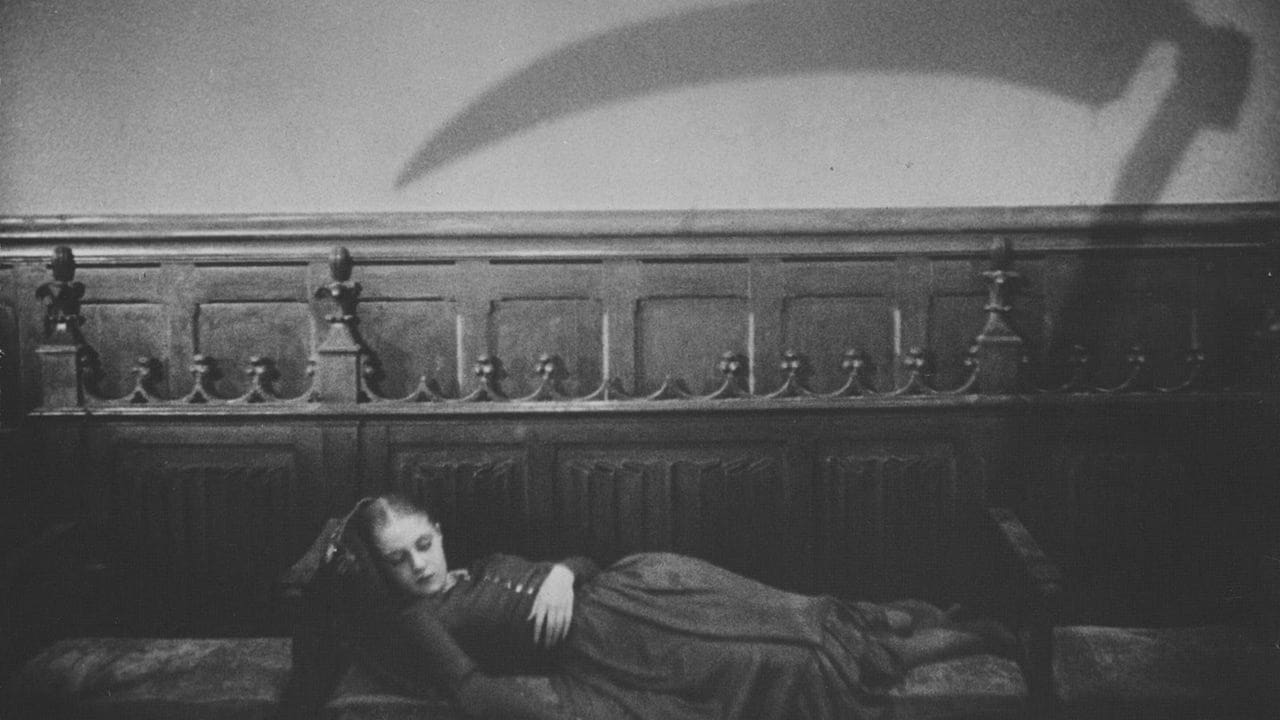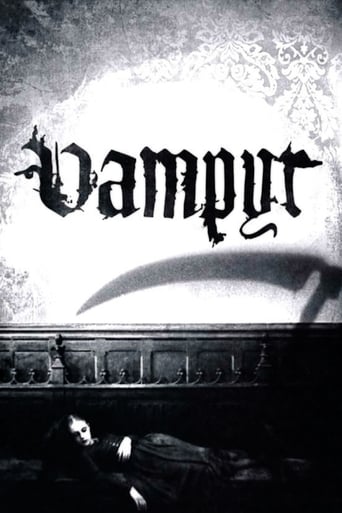

The Worst Film Ever
... View MoreCharming and brutal
... View MoreEntertaining from beginning to end, it maintains the spirit of the franchise while establishing it's own seal with a fun cast
... View MoreMostly, the movie is committed to the value of a good time.
... View MoreCarl Theodor Dreyer's first film with audible dialogue, "Vampyr" is a picture that rewards careful investigation and thought. It's like a nightmare and in part is quite surreal, or, perhaps more accurately, fantastic (another dreamlike genre debated in readings of the film by David Bordwell ("The Films of Carl Theodor Dreyer") and Noël Carroll ("Interpreting the Moving Image")). Even when the story seems logical (as far as supernatural horror goes), this logic and "reality" is obfuscated by the camera's shadowing the perspective of the expressionless protagonist, appropriately-named "Grey." This is further complicated by the camera assuming the role of an invisible character, as it sometimes abandons Grey's view entirely or momentarily seems to lose track of him. "Vampyr" is also interesting for how the then-new technology of talking pictures is synchronized with the dreamlike imagery."Vampyr," in fact, is not a synchronized-sound film. Photographed silent, sound was added in post-production. While technically primitive in this respect, and one can complain about the poor quality of the audio, as plenty have, "Vampyr" is conceptually far more sophisticated in its approach to sound than other early talkies. Most importantly, dubbing allowed Dreyer and company to not surrender to a sound stage their mastery of visual filmmaking from the silent-film era, as fully displayed in their prior masterpiece, "La passion de Jeanne d'Arc" (1928). The limitations of sound quality also surely inspired the beneficial sparsity of dialogue in general. And there's a non- diegetic musical score, which was a rarity in early talkies, despite its obvious prevalence in "silent" cinema.Compared to another early-talkie vampire film, "Dracula" (1931), for which many (including me) have claimed its eeriness is enhanced by the lack of a score, I don't think "Vampyr" loses any of its atmosphere with its balanced musical accompaniment, and it's enhanced by its relying even less on dialogue. The worst parts of "Dracula" are its scenes inside Seward's Sanitarium where characters jabber on and on—telling the action rather than showing it. Not so in "Vampyr." Even when characters refer to confusing or unheard sounds in the film, including to inaudible or unseen dogs, screams or a child, it adds to the surreal unease and subjectivity of events. At other points, the abrupt shifts in sounds underscore the shifting images, such as in the denouement where the images and sounds of factory machinery unleashing the doctor's comeuppance clash with those of a foggy, picturesque escape for the lovers. (By the way, this scene oddly reminds me of the climax in D.W. Griffith's "A Corner in Wheat" (1908), which is otherwise a completely different kind of film.)Visually, the soft-focus, dreamlike imagery of "Vampyr" was achieved with a gauze filter. The mobile camera, with tracking shots and dolly movements throughout the interiors and pans and tilts for the landscapes, lends to the narrative's fantastic confusion and controls the perspective, as the explanation for events are delayed, if revealed at all. The wonderful "fleeting shadows" sequence, for instance, which at first seems like Grey's hallucination, is later "explained" as part of the supernatural power of vampires. (The use of shadows, narration by intertitles and the vampire book were surely inspired by F.W. Murnau's 1922 "Nosferatu," a loose adaptation of Bram Stoker's novel "Dracula.") Other images, too, later turn out to have added meaning when given context. A seemingly-menacing ferryman bearing a scythe seems to portend the grim reaper. The appearances of a man in Grey's room and a woman in the factory are entirely mysterious at first, as well. Other scenes, such as the large supernatural head of the dead father taking revenge on the doctor, which includes a lengthy event behind a closed door, are never fully revealed. Some of the film may be further obscured by lost footage from censorship and the age and wear of the surviving prints, as well as editing choices Dreyer made.In addition to the limited perspective, Carroll, as well as Bordwell, cites the film's missing of a protentive structure, which normal films such as "Dracula" have through foreshadowing, for spectator's difficulty in following the plot and that what spectator expectations are formed are sometimes confounded. Furthermore, "Vampyr" has no skeptics in its supernatural story and so foregoes the confirmation phase where skepticism is defeated in the "complex discovery plot"—a structure Carroll has defined and which most other horror films abide.The climax of these threads, between the surreal, fantastic and logical supernatural-horror narrative and Grey's and the camera's subjectivity occurs with Grey's multilayered out-of-body experience, or dream-within-a-dream. After donating blood to a vampire victim, Grey wanders to a bench, whereupon his superimposed self leaves his body. The film follows the superimposition until he hides after discovering another body of himself paralyzed in a coffin. From here, we get point-of-view shots from the unblinking body—as Grey is about to be buried alive. But, then, the superimposition returns to Grey's body sited on the bench. In any sense of the word, this is a fantastic sequence. After it, Grey helps kill the vampire, which is one of the few actions he takes to resolve the narrative's crisis. The main hero, the old servant, acts against the vampire threat at the outskirts of a plot obscured by Grey's perplexed perspective.
... View MoreWhat a f*cking masterpiece.Late one night, a mysterious man shows up at the bedside of Allan Gray- a psychic medium who seems to possess the ability of astral projection. This man offers him an ominous warning and gives him a package that is to be opened "after his death".Upon waking, Allan is led by "shadow people" to the house of this same man...just in time to witness shadowy demons murder him.He tries to intervene, but it is too late...the man dies...Seeing Dreyer's mindblowing display of light and shadows in action, really makes you realize how effective such a device can be- and what a lost art it has become in modern horror.Watching this segment of the film is kind of like going on one of those carnival haunted house rides. The camera is always in motion, turning to catch the action, as if to mimic how we would react from the position of the rider (which we, as viewers, are in).Anyways...after the man dies, Allan opens the package. Finding that it contains a book on the history of Vampires.It is evident that the old man feared there would be no one there to stop the vampires from preying on his loved ones after his demise. And he had good reason to be afraid, because the vampires have their eyes set on his daughters. Hence the ominous warning provided to Allan the night before.He feels a moral obligation to protect her. But, as soon as no one is paying attention, the vampire lures her out and bites her. Now Allan is left trying to figure out how to save her.Luckily, the caretaker (the unsung hero of the film) figures it out.While Allan is out on all his psychedelic spy mission odysseys- gathering intel and trying to save the old man's other daughter. It's the caretaker who does all the grunt work and vampire slaying. And the only way the eldest daughter could truly be safe; is once the Master has experienced the "True Death", mind you.This film was way ahead of it's time. It has an almost modern feel, despite coming from pre-world war II Germany. And it's probably the most influential vampire film ever made. Most of the vampire sub-genre is indebted to this film. The special effects are as flawless as the transitions from altered state to reality (with the farmer seemingly acting as the psychopomp). The acting is absolutely brilliant- particularly with the main character. And that ending is downright hilarious!!! Can't believe it took me this long to see this. An absolute classic.9 out of 10.
... View MoreFrom what I understand this movie was originally filmed in German, French and English but for some reason the English version was either lost or destroyed. As a result, the movie I watched was in German but had English subtitles. Now normally this wouldn't be an issue but the director (Carl Theodor Dryer) chose a unique film style which incorporated both silent and sound techniques. Flash cards were used on occasion and what dialogue was available was somewhat minimal. Likewise, the film quality was a little blurry in some areas but surprisingly this tended to blend in with the overall plot rather than detract from it as the director made excellent use of shadows to create a dream-like state. Or in this specific case—something resembling a nightmare. Be that as it may, although I am not particularly fond of silent movies, for some odd reason this film proved to be the exception to the rule as it seemed both artistic and surreal. As a result I have rated this movie accordingly. Above average.
... View MoreI'm not exactly a fan of most really old films, most of them just don't really hold up for me or are just not my cup of tea; could be a generation thing or just simply me I don't know. But this is one of those gems that I really can sink my teeth into.I'll admit to me this is probably one of the most bizarre horror films I've seen. It's a vampire film and yet it isn't; to me it's kinda more of an art horror film since there really isn't much in story or characterization, it's a film where were really in it for the visuals and this film had got some damn good visuals which help make this not just a classic but a great experience.The film to me is sort of has a dreamlike quality to it as if your walking into a nightmare. From just the use of light, shadow, as well as most of the countryside and shack they shot the film at they've succeeded in creating a world that is dark, foreboding, where there can be danger hiding within the shadows, or in the next room. The music is great it has a very eerie tone to it that evokes a feeling of unsettlement or even dread in some places.But of course the visuals are the highlight of the film, you might even have to watch this film again just to uncover more. From some room with skulls and strange items in it, a witches room? Shadows moving in places and disconnected from other presences. A character seeing his own death which I'll admit was creepy because like him I wondered when the heck did that happen, then turning into a ghost for a while. But my favorite and to me most creepy visual was the infamous bellman with a scythe, it looked like the grim reaper to me.I'm not sure whether the film has a theme or not, it sort of left up to you to draw your own conclusions on that. To me I always thought it was on the fear and inexcapablity of death, since images of death are invoked throughout the film. Or even our never ending fear and attraction toward the darkness of life and ourselves, since the main character always goes toward dangerous locations in the film and the lure and temptation of vampirism becomes strong for one woman bitten by a vamp. I don't know like I said it's up to you which to me is part of what makes the film special.Venture into the darkness if you dare.Rating: 4 stars
... View More